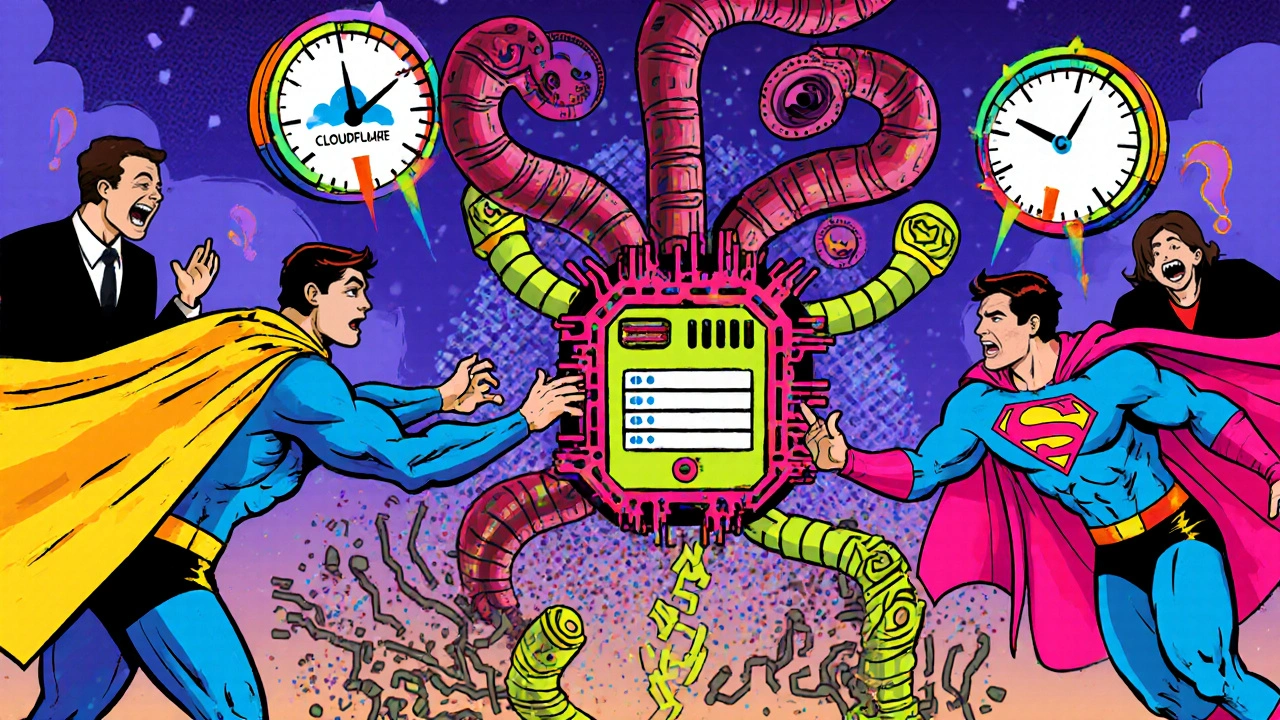Fintech DDoS Protection Needs Calculator
Assess Your DDoS Protection Needs
Calculate which enterprise DDoS protection solution best matches your fintech application's traffic patterns, budget, and compliance requirements.
Recommended DDoS Protection Solution
Max RPS Handling
Latency During Attack
Estimated Cost
Key Benefits
Why Avoid Other Options
When your app handles payments, transfers, or trading in real time, a single minute of downtime can cost more than $6 million. For fintech companies, DDoS attacks aren’t just an inconvenience-they’re a direct threat to survival. Unlike a website crash from too many visitors, DDoS attacks are deliberate, coordinated, and designed to look like real traffic. In 2025, financial institutions face nearly 13,000 DDoS attacks per year on average. That’s more than 35 per day. And it’s only getting worse.
Why Fintech Is a Prime Target
Fintech apps don’t just move money-they move trust. When a payment fails, a stock trade doesn’t execute, or a digital wallet freezes, users don’t just get frustrated. They lose confidence. And once trust is broken, it’s hard to rebuild. That’s why attackers target fintech specifically. They know the financial impact isn’t just technical-it’s reputational, legal, and existential. The most dangerous attacks today aren’t the old-school flood-of-packets type. They’re Layer 7 attacks. These don’t overwhelm your server with traffic volume. Instead, they mimic real users. A bot sends 100,000 HTTP requests per second-each one looking like a legitimate login, balance check, or payment request. Traditional firewalls can’t tell the difference. And by the time you notice, your API is down, your customers are angry, and your compliance auditors are calling. In 2024, DNS Query Floods surged by 272% globally. North American fintechs saw a 17% spike in attack volume. One attack in Q1 2025 hit 1.125 Tbps. That’s enough to swamp the entire internet backbone of a small country. And new attack patterns like ‘MadeYouReset’-a flaw in HTTP/2 that lets attackers bypass rate limits-are making things even harder.What Real Protection Looks Like
Free or basic DDoS tools won’t cut it. Cloudflare’s free tier? It’s great for blogs. Not for a payment gateway processing 50,000 transactions an hour. If you’re relying on AWS Shield Standard or a basic CDN, you’re playing Russian roulette with your business. Enterprise-grade DDoS protection for fintech needs four things:- Real-time machine learning that learns what normal user behavior looks like-down to the millisecond. It doesn’t just block IPs. It understands if a user is logging in from a new device, using an old browser, or clicking too fast.
- Multi-vector defense that handles HTTP floods, DNS amplification, and bot bursts at the same time. In H2 2024, 68% of attacks on financial services used multiple vectors. One tool can’t stop all of them.
- Sub-100ms latency. Every extra millisecond adds up. If your protection adds 300ms to every transaction, your app feels slow. And in finance, slow means lost sales. Top solutions keep added latency under 50ms-even during attacks.
- Compliance-ready. PCI DSS 4.1, GDPR, RBI guidelines, and the new EU DORA regulation all require continuous monitoring. Annual penetration tests? No longer enough. You need 24/7 validation.
Cloudflare vs. Akamai vs. Radware
There are three main players in the enterprise space-and each has trade-offs.| Feature | Cloudflare Pro | Akamai Enterprise Shield | Radware AppWall |
|---|---|---|---|
| Max RPS Handling | 100,000 | 150,000+ | 200,000+ |
| Layer 7 AI Detection | Yes | Yes | Yes, with behavioral modeling |
| Latency Added During Attack | 70-120ms | 40-80ms | 30-60ms |
| Monthly Cost (Est.) | $200-$5,000 | $8,000-$25,000 | $5,000-$18,000 |
| API Security Integration | Basic | Advanced | Best-in-class |
| Implementation Time | 2-4 weeks | 12-20 weeks | 8-16 weeks |
Cloudflare’s Pro plan works for startups under 10,000 daily transactions. But when you hit API spikes during trading hours or holiday sales, it often fails. One fintech on Reddit reported 12 minutes of downtime during a 50,000 RPS attack-even with Cloudflare Pro.
Akamai handles massive attacks with precision. Their solution is used by major banks. But setup is complex. One European bank saw their costs jump 32% after their first big attack because they didn’t realize how pricing tiers scaled.
Radware stands out for fintech-specific needs. Their AppWall can detect the ‘MadeYouReset’ vulnerability within hours of its discovery. It reduces false positives by 63% during high-volume trading. But the documentation is dense. You’ll need a dedicated security engineer or vendor support to get it right.

What Most Fintechs Get Wrong
The biggest mistake? Thinking DDoS protection is a one-time setup. You can’t just buy a tool and forget it. Attack patterns change. Your API endpoints evolve. New integrations open new attack surfaces. According to MazeBolt’s 2025 study, 68% of failed protections were due to misconfigured third-party APIs-especially with open banking systems like PSD2 or UPI. Another common error: skipping SSL/TLS inspection. If your DDoS tool can’t decrypt and inspect HTTPS traffic, it’s blind to half the attack surface. Top solutions process 50,000+ certificates per second without slowing things down. And then there’s the myth of “perimeter security.” Gartner warns that fintechs relying only on network-level firewalls will see 37% more successful attacks than those using layered defense. You need protection at the application layer-where the money moves.How to Build a Real Defense
Here’s how to actually protect your fintech app in 2025:- Start with a baseline. If you’re under 10,000 daily transactions, Cloudflare Pro is fine. But track your traffic patterns. If you see spikes during market hours or payment windows, plan to upgrade.
- Test like you’re under attack. Use a continuous validation platform like RADAR™. Don’t wait for an annual red team exercise. Run automated simulations weekly.
- Lock down your APIs. Require token-based auth, rate limiting per user, and anomaly detection on endpoint usage. If someone hits your /transfer endpoint 50 times in 3 seconds, block them-before they bring you down.
- Choose a provider with financial industry experience. Ask: “Have you mitigated an attack on a payment processor before?” If they say “We’ve done it for retail,” walk away.
- Train your team. DDoS mitigation specialists in North America earn $145,000/year on average. You don’t need to hire one full-time-but you need someone who understands how financial traffic behaves.
The Future Is AI vs. AI
By late 2026, traditional signature-based detection will be useless. Attackers are already using AI to adapt their traffic patterns in real time. If your system relies on known attack signatures, you’re already behind. Cloudflare’s Project Nova (coming Q3 2025) trains its AI on 1.2 billion financial transaction patterns. Radware’s ThreatAdapt 2.0 (Q1 2026) will auto-adjust defenses within 8 seconds of detecting a new attack. This isn’t science fiction-it’s the new standard. The smartest fintechs are now merging DDoS protection with fraud detection. When the same system that blocks a DDoS attack also flags an account takeover attempt, you reduce fraud by 41%, according to Promon.io’s case studies. That’s not just uptime-it’s revenue protection.Final Reality Check
The global DDoS protection market for financial services will hit $6.24 billion by 2027. That’s because 92% of banks with over $10 billion in assets are already investing. Meanwhile, only 29% of fintech startups use advanced Layer 7 defenses. If you’re a small fintech, don’t wait until you’re attacked to act. The cost of a single outage isn’t just financial-it’s customer trust, regulatory fines, and brand damage. And those don’t show up on your balance sheet until it’s too late. Your app doesn’t need to be perfect. It just needs to stay online when it matters most. That’s not a feature. It’s your license to operate.What’s the difference between Layer 3 and Layer 7 DDoS attacks?
Layer 3 attacks flood your network with traffic-like a truck blocking a highway. Layer 7 attacks target your app itself, sending fake but realistic requests to your API, login pages, or payment endpoints. Layer 7 is harder to detect because it looks like real users. For fintech, Layer 7 is the real threat-because that’s where money moves.
Can I use Cloudflare’s free plan for my fintech app?
Only if you’re processing fewer than 10,000 daily transactions and don’t handle real-time payments. Cloudflare’s free tier blocks basic volumetric attacks but offers no advanced Layer 7 protection, rate limiting per user, or API security. Most fintechs outgrow it within months. Once you hit API spikes during trading hours, you’ll be vulnerable.
How much does enterprise DDoS protection cost?
Costs vary by traffic and features. Cloudflare Pro starts at $200/month for small apps. Akamai and Radware start around $5,000-$8,000/month and scale up based on attack volume and custom integrations. Many fintechs pay $15,000-$25,000/month after major growth or regulatory audits. The cost of downtime-over $6 million per incident-makes this one of the cheapest security investments you’ll make.
Do I need a dedicated DDoS specialist on my team?
You don’t need a full-time hire if you’re using a managed service like Radware or Akamai. But you do need someone who understands financial traffic patterns, API security, and PCI DSS 4.1 requirements. This is often a senior DevOps engineer or security lead. Outsourcing to a vendor with fintech experience is often more cost-effective than building an in-house team.
What happens if I don’t upgrade my DDoS protection?
You’ll face longer outages, higher customer churn, and regulatory penalties. The EU’s DORA regulation requires continuous DDoS validation starting January 2026. The FFIEC and PCI Council now require proof of real-time monitoring. If you’re caught unprepared, you could lose your license to operate. More importantly, your users will leave-and they won’t come back.
Is AI-powered DDoS protection worth the hype?
Yes-if it’s trained on financial data. Generic AI models trained on web traffic won’t recognize a stock trading bot from a real user. The best solutions use machine learning models trained on billions of real financial transactions. They learn what a normal payment looks like-not just what an attack looks like. That’s the only way to stop adaptive attacks before they hit.
Next Steps for Fintech Teams
If you’re still using basic protection:- Run a traffic audit. How many requests does your API handle during peak hours?
- Ask your provider: “Can you stop a 100,000 RPS HTTP flood without slowing real users?”
- Check your compliance status. Are you meeting PCI DSS 4.1’s continuous monitoring requirement?
- Set a timeline. If you’re growing, upgrade within 90 days. Don’t wait for an attack to force your hand.
Your app doesn’t need to be flashy. It needs to be reliable. And in fintech, reliability isn’t optional-it’s the foundation of everything.






Comments
Okay but let’s be real - if you’re still on Cloudflare Free, you’re basically leaving your front door wide open while yelling ‘come get my money!’ I saw a startup go down for 17 minutes during Black Friday because their ‘DDoS protection’ was just a basic rate limiter. By the time they reacted, half their users had already switched to the competitor who didn’t glitch. Layer 7 isn’t optional anymore - it’s the new baseline. If your security team doesn’t speak HTTP/2 and behavioral anomalies like it’s their second language, you’re already behind.
And don’t even get me started on SSL inspection. If your WAF can’t decrypt and inspect traffic without turning your app into a slideshow, you’re not protected - you’re just pretending.
PS: Radware’s AppWall? Yeah, the docs are a maze, but once you get it running, it’s like having a ninja guard who knows exactly when someone’s faking a login. Worth the headache.
Utterly unacceptable. The notion that any fintech would consider Cloudflare Pro as anything other than a liability is not just negligent - it’s criminally irresponsible. We are not talking about a blog with 500 daily visitors. We are talking about systems that move capital in real time, under regulatory scrutiny, with legal exposure measured in seven figures per minute. The fact that this article even entertains the idea of ‘starting small’ is a symptom of a systemic failure in the industry’s risk culture.
Akamai and Radware are not ‘expensive options’ - they are the minimum viable standard. Any CFO who balks at $8,000/month while risking $6M in downtime per incident should be removed from their position. And the myth of ‘we’ll upgrade when we grow’? That’s how startups become cautionary tales on TechCrunch.
Compliance is not a checkbox. It’s a continuous, real-time, encrypted, AI-driven defense posture. If you’re not operating at that level, you’re not in fintech - you’re in fantasy.
It’s fascinating, isn’t it, how we’ve come to treat digital infrastructure as if it were a public utility - something that should just… work - without ever asking who’s holding the reins? We build apps that move money, that alter lives, that shape economic trust - and yet we treat their security like a side project, something we’ll get to after the MVP, after the funding round, after the holiday spike.
But here’s the quiet truth: trust is not built in marketing campaigns or shiny UIs. It’s built in milliseconds - in the quiet, invisible moments when your system holds firm while a thousand bots try to tear it down. And those moments? They’re not glamorous. They’re not viral. They’re just… there.
AI-powered defense isn’t hype. It’s evolution. Just as we stopped relying on manual ledgers and embraced accounting software, we must stop relying on signatures and embrace behavioral learning. The attack surface isn’t just expanding - it’s becoming sentient. And if we don’t match its intelligence, we won’t just lose transactions - we’ll lose the very idea that digital finance can be safe.
Maybe the real question isn’t ‘how much does protection cost?’ but ‘how much are we willing to lose by not caring enough?’
Bro, the ‘MadeYouReset’ exploit? That’s wild. Radware caught it in hours? That’s next level. I was on a call last week with a fintech dev who said their ‘enterprise solution’ was just Cloudflare + a cron job that restarts nginx every 10 minutes. I nearly choked on my coffee.
Real talk - if you’re not doing behavioral ML on API calls, you’re just a glorified toll booth. Bots don’t care about your firewall rules. They care about your login endpoint’s latency, your token expiration window, your session cookie structure. That’s where the real game is.
And yeah, Akamai’s setup takes forever, but honestly? That’s the point. If it’s easy, it’s not secure. The best defenses are the ones that make you sweat during deployment. If your security engineer isn’t crying at least once during integration, you’re probably doing it wrong.
Also, stop using free SSL certs on payment endpoints. That’s not ‘saving money’ - that’s asking for a MITM party.
Wow. Just… wow. You wrote an entire essay about DDoS protection and didn’t even mention that 90% of these ‘enterprise solutions’ are just rebranded CDN services with a $10k/month markup. You think Radware’s ‘best-in-class API security’ is magic? Nah. It’s just better marketing and a sales team that knows how to say ‘PCI DSS’ without laughing.
Let’s be honest - most fintechs don’t need $20k/month protection. They need to stop exposing their entire API surface to the public internet. Lock down your endpoints. Use OAuth2. Implement device fingerprinting. Stop treating your backend like a public API playground.
And no, AI doesn’t fix bad architecture. It just makes your outage look more ‘sophisticated’ while you’re still down. The real solution? Less complexity. Fewer integrations. Less ‘innovation’ and more discipline.
Also, if you’re paying for ‘continuous monitoring,’ you’re probably already compromised. The best defense? Don’t give attackers anything to attack.